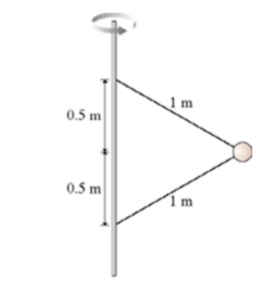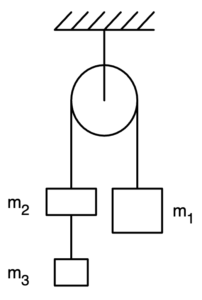0 attempts
0% avg
UBQ Credits
| Step | Formula Derivation | Reasoning |
|---|---|---|
| 1 | [katex] f_s \leq \mu_s n [/katex] | Static friction is less than or equal to the product of the static friction coefficient and the normal force. |
| 2 | [katex] F = m_{\text{total}} \cdot a [/katex] | Total force equals total mass times acceleration. |
| 3 | [katex] a = \frac{F}{m_{\text{total}}} [/katex] | Acceleration of the system. |
| 4 | [katex] f_s = m_{1} \cdot a [/katex] | Frictional force must equal the force required to accelerate block 1. |
| 5 | [katex] n = m_{1} \cdot g [/katex] | Normal force on block 1 is its weight. |
| 6 | [katex] \mu_s = \frac{f_s}{n} [/katex] | Coefficient of static friction formula. |
| 7 | [katex] m_{\text{total}} = 3m [/katex] | Total mass is the sum of all three blocks. |
| 8 | [katex] a = \frac{F}{3m} [/katex] | Substitute total mass into acceleration formula. |
| 9 | [katex] \mu_s = \frac{m \cdot \frac{F}{3m}}{m \cdot g} [/katex] | Combine steps 4, 5, and 8. |
| 10 | [katex] \mu_s = \frac{F}{3mg} [/katex] | Simplify the equation. |
[katex] \boxed{\mu_s = \frac{F}{3mg}} [/katex]
The minimum coefficient of static friction that ensures block 1 accelerates at the same rate as block 2 is [katex] \frac{F}{3mg} [/katex], which corresponds to option (D).
Just ask: "Help me solve this problem."
On a harsh winter day, a \( 1500 \) \( \text{kg} \) vehicle takes a circular banked exit ramp (radius \( R = 150 \) \( \text{m} \); banking angle of \( 10^\circ \)) at a speed of \( 30 \) \( \text{mph} \), since the speed limit is \( 35 \) \( \text{mph} \). However, the exit ramp is completely iced up (frictionless). To make matters worse, a wind is blowing parallel to the ramp in a downward direction. The wind exerts a force of \( 3000 \) \( \text{N} \). Under these conditions, can the driver continue to follow a safe horizontal circle on the exit ramp and stay below the speed limit?
To convert \( \text{mph} \) into \( \text{m/s} \), use \( 1 \) \( \text{mi} = 1607 \) \( \text{m} \) and \( 1 \) \( \text{hr} = 3600 \) \( \text{s} \).
A child on Earth has a weight of \(500 \, \text{N}\). Determine the weight of the child if the Earth were to triple in both mass and radius (\(3M\) and \(3r\)).

Two wires are tied to the \(500 \, \text{g}\) sphere as shown above. The sphere revolves in a horizontal circle at a constant speed of \(7.2 \, \text{m/s}\). What is the tension in the upper wire? What is the tension in the lower wire?
A small sphere hangs from a string attached to the ceiling of a uniformly accelerating train car. It is observed that the string makes an angle of \(37^\circ\) with respect to the vertical. The magnitude of the acceleration \(a\) of the train car is most nearly:

Three blocks of masses \(m_3 = 1.0 \, \text{kg}\), \(m_2 = 2.0 \, \text{kg}\), and \(m_1 = 4.0 \, \text{kg}\) are connected by massless strings, one of which passes over a frictionless pulley of negligible mass, as shown above.
By continuing you (1) agree to our Terms of Use and Terms of Sale and (2) consent to sharing your IP and browser information used by this site’s security protocols as outlined in our Privacy Policy.
| Kinematics | Forces |
|---|---|
| \(\Delta x = v_i t + \frac{1}{2} at^2\) | \(F = ma\) |
| \(v = v_i + at\) | \(F_g = \frac{G m_1 m_2}{r^2}\) |
| \(v^2 = v_i^2 + 2a \Delta x\) | \(f = \mu N\) |
| \(\Delta x = \frac{v_i + v}{2} t\) | \(F_s =-kx\) |
| \(v^2 = v_f^2 \,-\, 2a \Delta x\) |
| Circular Motion | Energy |
|---|---|
| \(F_c = \frac{mv^2}{r}\) | \(KE = \frac{1}{2} mv^2\) |
| \(a_c = \frac{v^2}{r}\) | \(PE = mgh\) |
| \(T = 2\pi \sqrt{\frac{r}{g}}\) | \(KE_i + PE_i = KE_f + PE_f\) |
| \(W = Fd \cos\theta\) |
| Momentum | Torque and Rotations |
|---|---|
| \(p = mv\) | \(\tau = r \cdot F \cdot \sin(\theta)\) |
| \(J = \Delta p\) | \(I = \sum mr^2\) |
| \(p_i = p_f\) | \(L = I \cdot \omega\) |
| Simple Harmonic Motion | Fluids |
|---|---|
| \(F = -kx\) | \(P = \frac{F}{A}\) |
| \(T = 2\pi \sqrt{\frac{l}{g}}\) | \(P_{\text{total}} = P_{\text{atm}} + \rho gh\) |
| \(T = 2\pi \sqrt{\frac{m}{k}}\) | \(Q = Av\) |
| \(x(t) = A \cos(\omega t + \phi)\) | \(F_b = \rho V g\) |
| \(a = -\omega^2 x\) | \(A_1v_1 = A_2v_2\) |
| Constant | Description |
|---|---|
| [katex]g[/katex] | Acceleration due to gravity, typically [katex]9.8 , \text{m/s}^2[/katex] on Earth’s surface |
| [katex]G[/katex] | Universal Gravitational Constant, [katex]6.674 \times 10^{-11} , \text{N} \cdot \text{m}^2/\text{kg}^2[/katex] |
| [katex]\mu_k[/katex] and [katex]\mu_s[/katex] | Coefficients of kinetic ([katex]\mu_k[/katex]) and static ([katex]\mu_s[/katex]) friction, dimensionless. Static friction ([katex]\mu_s[/katex]) is usually greater than kinetic friction ([katex]\mu_k[/katex]) as it resists the start of motion. |
| [katex]k[/katex] | Spring constant, in [katex]\text{N/m}[/katex] |
| [katex] M_E = 5.972 \times 10^{24} , \text{kg} [/katex] | Mass of the Earth |
| [katex] M_M = 7.348 \times 10^{22} , \text{kg} [/katex] | Mass of the Moon |
| [katex] M_M = 1.989 \times 10^{30} , \text{kg} [/katex] | Mass of the Sun |
| Variable | SI Unit |
|---|---|
| [katex]s[/katex] (Displacement) | [katex]\text{meters (m)}[/katex] |
| [katex]v[/katex] (Velocity) | [katex]\text{meters per second (m/s)}[/katex] |
| [katex]a[/katex] (Acceleration) | [katex]\text{meters per second squared (m/s}^2\text{)}[/katex] |
| [katex]t[/katex] (Time) | [katex]\text{seconds (s)}[/katex] |
| [katex]m[/katex] (Mass) | [katex]\text{kilograms (kg)}[/katex] |
| Variable | Derived SI Unit |
|---|---|
| [katex]F[/katex] (Force) | [katex]\text{newtons (N)}[/katex] |
| [katex]E[/katex], [katex]PE[/katex], [katex]KE[/katex] (Energy, Potential Energy, Kinetic Energy) | [katex]\text{joules (J)}[/katex] |
| [katex]P[/katex] (Power) | [katex]\text{watts (W)}[/katex] |
| [katex]p[/katex] (Momentum) | [katex]\text{kilogram meters per second (kgm/s)}[/katex] |
| [katex]\omega[/katex] (Angular Velocity) | [katex]\text{radians per second (rad/s)}[/katex] |
| [katex]\tau[/katex] (Torque) | [katex]\text{newton meters (Nm)}[/katex] |
| [katex]I[/katex] (Moment of Inertia) | [katex]\text{kilogram meter squared (kgm}^2\text{)}[/katex] |
| [katex]f[/katex] (Frequency) | [katex]\text{hertz (Hz)}[/katex] |
General Metric Conversion Chart
Example of using unit analysis: Convert 5 kilometers to millimeters.
Start with the given measurement: [katex]\text{5 km}[/katex]
Use the conversion factors for kilometers to meters and meters to millimeters: [katex]\text{5 km} \times \frac{10^3 \, \text{m}}{1 \, \text{km}} \times \frac{10^3 \, \text{mm}}{1 \, \text{m}}[/katex]
Perform the multiplication: [katex]\text{5 km} \times \frac{10^3 \, \text{m}}{1 \, \text{km}} \times \frac{10^3 \, \text{mm}}{1 \, \text{m}} = 5 \times 10^3 \times 10^3 \, \text{mm}[/katex]
Simplify to get the final answer: [katex]\boxed{5 \times 10^6 \, \text{mm}}[/katex]
Prefix | Symbol | Power of Ten | Equivalent |
|---|---|---|---|
Pico- | p | [katex]10^{-12}[/katex] | 0.000000000001 |
Nano- | n | [katex]10^{-9}[/katex] | 0.000000001 |
Micro- | µ | [katex]10^{-6}[/katex] | 0.000001 |
Milli- | m | [katex]10^{-3}[/katex] | 0.001 |
Centi- | c | [katex]10^{-2}[/katex] | 0.01 |
Deci- | d | [katex]10^{-1}[/katex] | 0.1 |
(Base unit) | – | [katex]10^{0}[/katex] | 1 |
Deca- or Deka- | da | [katex]10^{1}[/katex] | 10 |
Hecto- | h | [katex]10^{2}[/katex] | 100 |
Kilo- | k | [katex]10^{3}[/katex] | 1,000 |
Mega- | M | [katex]10^{6}[/katex] | 1,000,000 |
Giga- | G | [katex]10^{9}[/katex] | 1,000,000,000 |
Tera- | T | [katex]10^{12}[/katex] | 1,000,000,000,000 |
The most advanced version of Phy. 50% off, for early supporters. Prices increase soon.
per month
Billed Monthly. Cancel Anytime.
Trial –> Phy Pro
We crafted THE Ultimate A.P Physics 1 course so you can learn faster and score higher.
Try our free calculator to see what you need to get a 5 on the upcoming AP Physics 1 exam.
A quick explanation
Credits are used to grade your FRQs and GQs. Pro users get unlimited credits.
Submitting counts as 1 attempt.
Viewing answers or explanations count as a failed attempts.
Phy gives partial credit if needed
MCQs and GQs are are 1 point each. FRQs will state points for each part.
Phy customizes problem explanations based on what you struggle with. Just hit the explanation button to see.
Understand you mistakes quicker.

Phy automatically provides feedback so you can improve your responses.
10 Free Credits To Get You Started

By continuing you agree to nerd-notes.com Terms of Service, Privacy Policy, and our usage of user data.
NEW! PHY AI accurately solves all questions
🔥 Get up to 30% off Elite Physics Tutoring
🧠 NEW! Learn Physics From Scratch Self Paced Course
🎯 Need exam style practice questions?